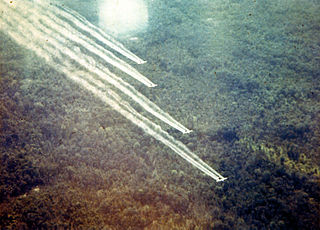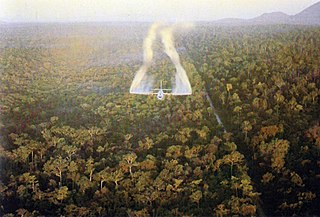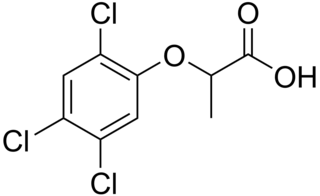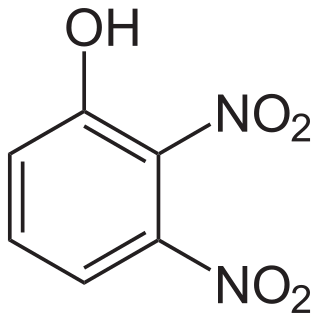
Agent Orange is a herbicide and defoliant chemical, one of the "tactical use" Rainbow Herbicides. It is widely known for its use by the U.S. military as part of its herbicidal warfare program, Operation Ranch Hand, during the Vietnam War from 1961 to 1971. It is a mixture of equal parts of two herbicides, 2,4,5-T and 2,4-D. In addition to its damaging environmental effects, traces of dioxin found in the mixture have caused major health problems for many individuals who were exposed.

Herbicides, British English: ), also commonly known as weedkillers, are chemical substances used to control unwanted plants. Selective herbicides control specific weed species, while leaving the desired crop relatively unharmed, while non-selective herbicides can be used to clear waste ground, industrial and construction sites, railways and railway embankments as they kill all plant material with which they come into contact. Apart from selective/non-selective, other important distinctions include persistence, means of uptake, and mechanism of action. Historically, products such as common salt and other metal salts were used as herbicides, however these have gradually fallen out of favor and in some countries a number of these are banned due to their persistence in soil, and toxicity and groundwater contamination concerns. Herbicides have also been used in warfare and conflict.

Operation Ranch Hand was a U.S. military operation during the Vietnam War, lasting from 1962 until 1971. Largely inspired by the British use of 2,4,5-T and 2,4-D during the Malayan Emergency in the 1950s, it was part of the overall herbicidal warfare program during the war called "Operation Trail Dust". Ranch Hand involved spraying an estimated 20 million U.S. gallons (76,000 m3) of defoliants and herbicides over rural areas of South Vietnam in an attempt to deprive the Viet Cong of food and vegetation cover. Areas of Laos and Cambodia were also sprayed to a lesser extent. Nearly 20,000 sorties were flown between 1961 and 1971.

Glyphosate is a broad-spectrum systemic herbicide and crop desiccant. It is an organophosphorus compound, specifically a phosphonate, which acts by inhibiting the plant enzyme 5-enolpyruvylshikimate-3-phosphate synthase. It is used to kill weeds, especially annual broadleaf weeds and grasses that compete with crops. It was discovered to be an herbicide by Monsanto chemist John E. Franz in 1970. Monsanto brought it to market for agricultural use in 1974 under the trade name Roundup. Monsanto's last commercially relevant United States patent expired in 2000.

Sodium chlorate is an inorganic compound with the chemical formula NaClO3. It is a white crystalline powder that is readily soluble in water. It is hygroscopic. It decomposes above 300 °C to release oxygen and leave sodium chloride. Several hundred million tons are produced annually, mainly for applications in bleaching paper.

Agent Purple is the code name for a powerful herbicide and defoliant used by the U.S. military in their herbicidal warfare program during the Vietnam War. The name comes from the purple stripe painted on the barrels to identify the contents. Largely inspired by the British use of herbicides and defoliants during the Malayan Emergency, it was one of the so-called "Rainbow Herbicides" that included the more infamous Agent Orange. Agent Purple and Orange were also used to clear brush in Canada.

A nucleophilic aromatic substitution is a substitution reaction in organic chemistry in which the nucleophile displaces a good leaving group, such as a halide, on an aromatic ring. There are 6 nucleophilic substitution mechanisms encountered with aromatic systems:

Agent White is the code name for a herbicide used by the U.S. military in its herbicidal warfare program during the Vietnam War. The name comes from the regulatory requirements of identifying each container of the various herbicides through the addition of colored stripes. Orange, Purple, Blue, and White were colors used by the manufacturers to ensure that the contents were easily identifiable in shipment and use. Colors were selected by the U.S. Government. Largely inspired by the British use of herbicides and defoliants during the Malayan Emergency, it was one of the so-called "rainbow herbicides".

Phenoxy herbicides are a family of chemicals related to the growth hormone indoleacetic acid (IAA). When sprayed on broad-leaf plants they induce rapid, uncontrolled growth. When sprayed on monocotyledonous (grass) crops such as wheat or corn, they selectively kill broad-leaf weeds, leaving the crops relatively unaffected. The wide variety of phenoxies in use today can be grouped into the phenoxyacetic, phenoxybutyric and phenoxypropionic subtypes, the latter containing the aryloxyphenoxypropionic subtype with the greatest number of commercial variants. Chemically, they are carboxylic acids, typically applied in an ester or salt form.
Nitrophenols are compounds of the formula HOC6H5-x(NO2)x. The conjugate bases are called nitrophenolates. Nitrophenols are more acidic than phenol itself.
The Rainbow Herbicides are a group of "tactical use" chemicals used by the United States military in Southeast Asia during the Vietnam War. Success with Project AGILE field tests with herbicides in South Vietnam in 1961 and inspiration by the British use of herbicides and defoliants during the Malayan Emergency in the 1950s led to the formal herbicidal program Trail Dust. Herbicidal warfare is the use of substances primarily designed to destroy the plant-based ecosystem of an agricultural food production and/or to destroy foliage which provides the enemy cover.

Fenoprop, or 2-(2,4,5-trichlorophenoxy) propionic acid, is an herbicide and a plant growth regulator. Fenoprop has been banned from use as an herbicide in the United States since 1985. The name Silvex was used in the USA. The name 2,4,5-TP is used in France and was used in the former USSR (2,4,5-ТП).

Pinacolone (3,3-dimethyl-2-butanone) is an important ketone in organic chemistry. It is a colorless liquid and has a slight peppermint- or camphor- odor. It is a precursor to triazolylpinacolone in the synthesis of the fungicide triadimefon and in synthesis of the herbicide metribuzin. The molecule is an unsymmetrical ketone. The α-methyl group can participate in condensation reactions. The carbonyl group can undergo the usual reactions. It is a Schedule 3 compound under the Chemical Weapons Convention 1993, due to being related to pinacolyl alcohol, which is used in the production of soman. It is also a controlled export in Australia Group member states.
This is an index of articles relating to pesticides.
The molecular formula C6H4N2O5 may refer to:

2,4-Dichlorophenoxyacetic acid (usually called 2,4-D) is an organic compound with the chemical formula C8H6Cl2O3. It is a systemic herbicide which selectively kills most broadleaf weeds by causing uncontrolled growth in them, but leaves most grasses such as cereals, lawn turf, and grassland relatively unaffected.

Cynazine is a herbicide that belongs to the group of triazines. Cyanazine inhibits photosynthesis and is therefore used as a herbicide.





















